Summary
-
Leaf spots and leaf blights are caused by numerous fungal pathogens, but the symptoms they cause are relatively similar for all of them.
-
All palms should be considered hosts for leaf spots and leaf blights, especially in the seedling and juvenile stages.
-
Leaf spots initially start as small, water-soaked lesions that then turn various shades of yellow, gray, reddish-brown, brown, or black. These lesions are usually surrounded by a halo or ring of tissue that is a different color.
-
Leaf spots can increase in number or size such that large portions of a leaf blade are diseased.
-
Sanitation and water management are critical for leaf spot and blight disease management, especially in a nursery (both container and field). Injury prevention and good palm nutrition are part of the overall management strategy.
-
Fungicides may be useful as part of an integrated management program. They should never be the sole component of a program.
Introduction
This fact sheet is limited to those diseases where the pathogens only infect (invade) and cause spots and blights of the leaf blade. Other diseases may cause death of leaflets and leaf segments but are actually the result of a pathogen infecting the leaf petiole or rachis. Petiole/rachis blight diseases are discussed separately at https://edis.ifas.ufl.edu/pp145.
As with anything in nature, there are exceptions. The primary exception is the fungal pathogen Pestalotiopsis, which can infect both the petiole and blade of the palm frond, especially those of Phoenix roebelinii (pygmy date palm). See the fact sheet on this pathogen at https://edis.ifas.ufl.edu/pp141. The leaf disease Graphiola leaf spot (false smut) is dealt with separately also, due to its unique characteristics, at https://edis.ifas.ufl.edu/pp140.
The difference between a leaf spot and a leaf blight concerns the degree of leaf blade damage. In general, as long as the spots are discretely separated from each other by green tissue, the disease is referred to as a spot. When these spots occur suddenly and merge together to form a larger mass of diseased tissue, the disease is referred to as a blight.
Pathogen and Hosts
The vast majority of leaf spots and leaf blights of palm are caused by fungi. In general, the symptoms look similar no matter which fungus is causing the spot or blight. Potential causes of leaf spots and leaf blights in Florida include Annellophora, Bipolaris, Cercospora, Colletotrichum, Calonectria (Cylindrocladium), Exserohilum, Gliocladium, Pestalotiopsis, Pestalotia, Phaeotrichoconis, Phyllachora, Pseudocercospora, and Stigmina.
All of these fungi produce some type of spore which can be easily spread by wind and water (rainfall or overhead irrigation). The spores can also be spread by pest activity (insects or rodents) or human activity (movement through nursery, pruning, etc.).
The complete host range for each of these pathogens is unknown, but it is assumed to be broad within palms. It is quite likely that every palm species is susceptible to at least one of these pathogens, especially in the juvenile stage. Also, most of these pathogens cause diseases on plants other than palms.
Leaf spots and leaf blights are usually more severe on palms in the seedling and juvenile stage of growth. Palms in the seedling stage are recently germinated and have leaves that still appear grass-like. Palms in the juvenile stage have no trunk, but their leaves can be differentiated as palmate (fan-like), costapalmate, or pinnate (feather-like). They are essentially a mass of leaf bases with the apical meristem (bud) at or near the soil line.
Symptoms
In general, the initial symptom for leaf spots is a small, water-soaked lesion (Figure 1). Within days, this lesion turns to varying shades of yellow, gray, reddish-brown, brown, or black. The colored lesions may be surrounded by a halo or ring of tissue that is a different color (Figure 1). For example: black spots surrounded by chlorotic (yellow) halos; yellow spots surrounded by reddish-brown rings or black rings; gray spots surrounded by a black ring, which is surrounded by a chlorotic halo. The common theme is that there is a disruption in the normal, uniform color of the leaf blade and that disruption is round or oblong in shape (Figure 2, Figure 3, and Figure 4). The size of the spots varies with each pathogen. Eventually, this diseased tissue will die.
If environmental conditions are optimum for the disease, the spots can increase in number or size such that large portions of a fan palm blade or large number of leaflets of a feather palm blade are diseased. If severe enough, entire leaflets or leaves may desiccate and die as lesions expand and coalesce, causing leaf blights.
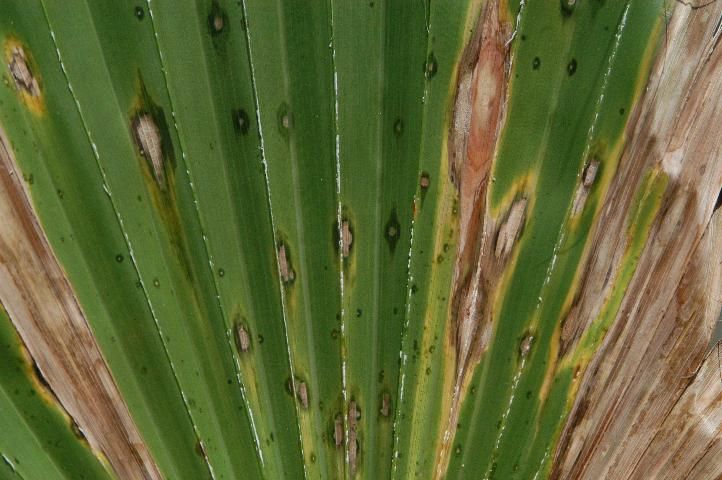
Credit: M. L. Elliott, UF/IFAS
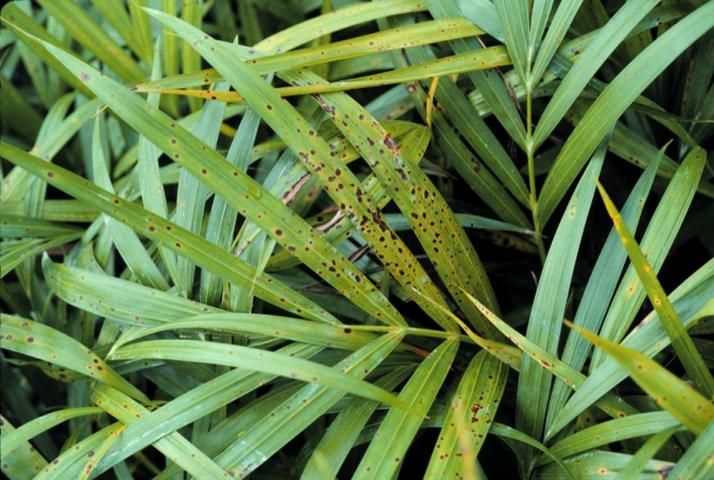
Credit: T. K. Broschat, UF/IFAS
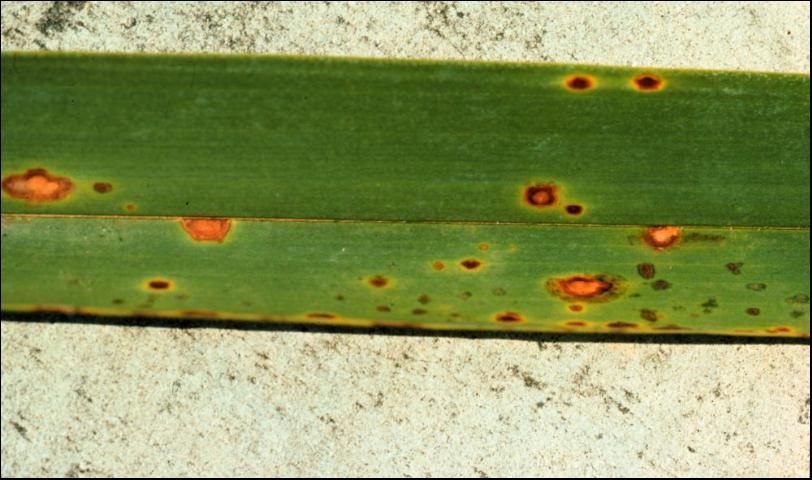
Credit: T. K. Broschat, UF/IFAS
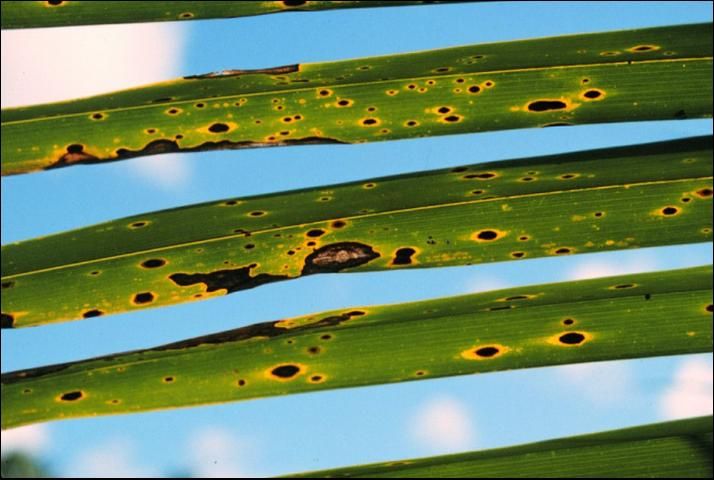
Credit: T. K. Broschat, UF/IFAS
Leaf spots usually appear on leaves of all ages. With juvenile palms that only have a few leaves, the leaf spots may appear on all leaves at the same time. With most leaf spot diseases, the pathogen will produce spores directly on the leaf tissue. These spores are spread by rain, overhead irrigation, wind, pest activity, and human activity. Water is not only critical for spread of the spores, but it is also critical for spore germination and infection (invasion) of the leaf tissue.
Potassium deficiency symptoms on the oldest leaves could be confused for a leaf spot, as these symptoms include yellow to orange transluscent spots or black spots. See https://edis.ifas.ufl.edu/EP273. Manganese deficiency symptoms on the youngest leaves could be confused for a leaf spot or blight also. These symptoms include interveinal, necrotic (dead) streaks. See https://edis.ifas.ufl.edu/EP267.
Diagnosis
The exact cause of a leaf spot is based on identification of the fungal pathogen. It is usually not possible to determine the pathogen without examining the fungal spores. These may be examined directly on the leaf tissue if spores are being produced or by placing the diseased leaf tissue in a moist chamber to induce sporulation. Isolation of the pathogen can be made on artificial media, and this growth then induced to sporulate.
It is not uncommon to observe or isolate more than one potential pathogen from the same diseased tissue. In some cases, it is apparent which fungus was the first pathogen to invade the healthy leaf blade tissue, while the second fungus moved into the resulting necrotic (dead) tissue as a saprobe.
The Florida Extension Plant Disease Clinic (FEPDC) network is available for pathogen identification. Contact your local UF/IFAS Extension office or FEPDC for details on sample submission and cost of a laboratory diagnosis.
Disease Management
Leaf diseases are usually more severe on juvenile palms in a container or field nursery situation than in the landscape for two reasons. First, leaf diseases are often more prevalent on juvenile palms (palms without trunks) than on mature palms, and more likely to be debilitating to the juvenile palm if they do occur. Second, in a nursery there are hundreds or thousands of juvenile palms spaced close together, often of the same species. This allows for relatively easy movement of spores from plant to plant. Most leaf diseases in the landscape are cosmetic, since mature palms dominate, are not spaced as close together, and are composed of a variety of species. While most of the management discussion below is targeted for nurseries, the statements apply in the landscape also.
Sanitation and water management are critical for leaf spot disease management. For water management, elimination of overhead irrigation or protection from rainfall is highly recommended. Leaf spots are minimal if leaves are kept dry. If this is not possible, time the irrigation so the leaves are wet for a minimal number of hours. This usually means irrigating in the hours before dawn. Increase air circulation to keep plants drier by increasing spacing between plants and making sure larger plants are not blocking air movement to smaller plants.
For juvenile palms, it has been observed that leaf spots are more severe when the palms are grown in full sun rather than with some shade.
The nursery should be constantly monitored for leaf diseases. Prune severely diseased leaves or eliminate the palm completely. This diseased material should be destroyed or removed from the nursery as it is a source of inoculum (spores that can infect healthy leaf tissue). If mature palms are on the property, monitor them for leaf disease also. While the disease may not be debilitating to a mature palm, a mature palm with leaf disease can still act as an inoculum source.
Most leaf spot pathogens have other hosts besides palms. If the nursery produces other ornamental plants, be aware of the diseases on these plants and whether there are pathogens common between these plants and palms. Likewise, weeds may serve as other hosts for the palm pathogens.
Some of the leaf spot pathogens appear to cause disease or become problematic diseases primarily on damaged plants. Injuries may allow the fungus to become established as a saprobe (non-pathogen) on the injured tissue, followed by fungal sporulation and then infection of healthy tissue by these fungal spores. Thus, preventing injury is crucial. Monitor and control insect and rodent pests. Leaf damage or injury due to water stress, sunburn, fertilizer burn, herbicide phytotoxicity, or cold temperatures should be avoided.
It has been observed that some fungal leaf pathogens are more severe on nutritionally-stressed palms. For example, Wodyetia bifurcata (foxtail palm) suffering from iron deficiency is more susceptible to leaf spots (Figure 5). Leaf spots due to potassium deficiency create injuries that allow leaf pathogens to become established. Thus, eliminating nutrient deficiencies is the first step in managing leaf spots and leaf blights.
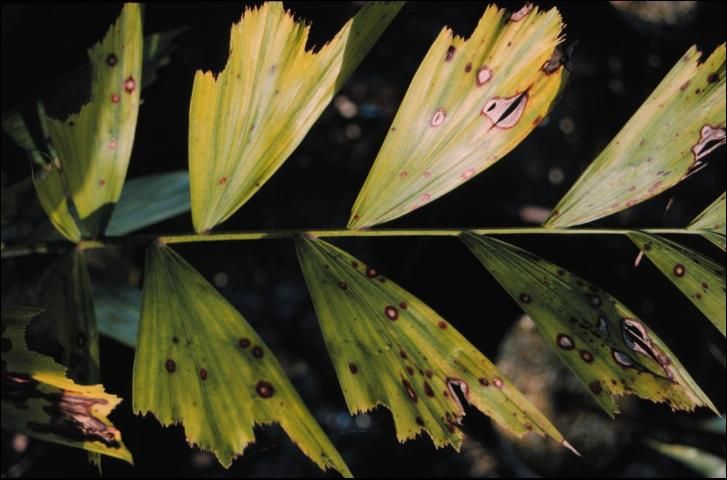
Credit: M. L. Elliott, UF/IFAS
While fungicides may be useful to prevent further spread of the disease, they are merely a supplement to water management, sanitation, injury prevention, and good palm nutrition. Fungicides alone will not solve the problem. It is critical to understand that fungicides do not cure the leaf spots already present. Once a spot occurs, it will remain for the duration of the life of that leaf. Fungicides are used to prevent further spread of the disease by protecting leaf tissue that has not been infected by the fungal pathogens.
In the nursery situation, prune severely diseased leaves prior to fungicide application. These leaves need to be removed anyway, and this will reduce the amount of fungicide used in the process. In the landscape situation, unless the leaf spot disease is severe, leaf pruning is not recommended unless the palm is free of nutrient deficiencies. In general, nutrient deficiencies are far more debilitating to the landscape palm than leaf spot diseases.
Fungicide trials to examine efficacy of these products on juvenile palms has been conducted for specific host/pathogen groups, particularly the Helminthosporium group of fungi (Bipolaris, Exserohilum, and Phaeotrichoconis). In general, if the fungicide is efficacious against the specific pathogen on other ornamental plants, it will probably be efficacious against the pathogen on palms. Contact fungicides need to be uniformly applied to leaf tissue to protect against infection. Refer to https://edis.ifas.ufl.edu/pp154 for a list of fungicides that may be used in the landscape. Fungicides must be applied according to the label.
Selected References
Broschat, T. K. and M. L. Elliott. 2005. "Effects of iron source on iron chlorosis and Exserohilum leaf spot severity in Wodyetia bifurcata." HortScience 40: 218–220.
Chase, A. R. 1993. "Common diseases of palms." Southern Nursery Digest March: 20–21.
Elliott, M. L., T. K. Broschat, J. Y. Uchida, and G. W. Simone. 2004. Compendium of Ornamental Palm Diseases and Disorders. American Phytopathological Society, St. Paul, MN. (multiple sections on leaf spot diseases).